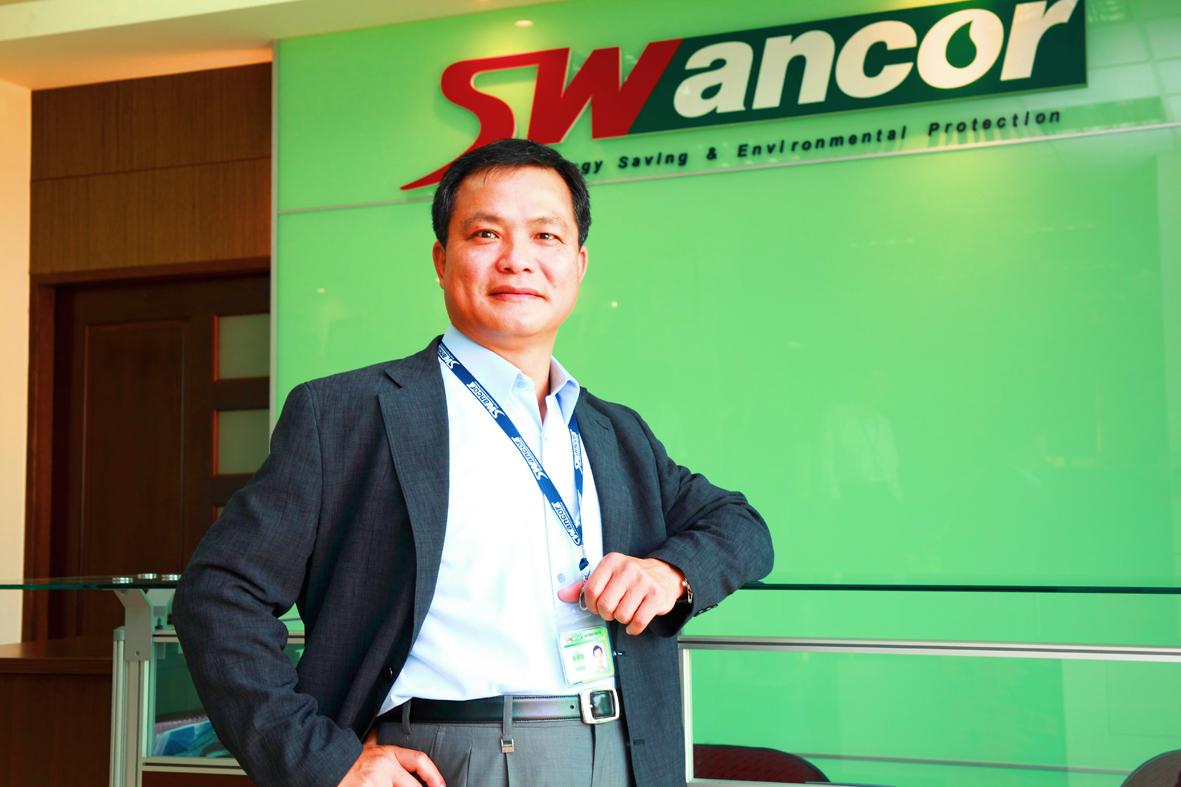Resins and composite materials manufacturer Swancor Holding Co Ltd (上緯投控) expects this quarter’s revenue to remain the same as last quarter despite the effects of traditional seasonality, after last quarter’s revenue was the highest in the company’s history.
Third-quarter revenue was NT$3.01 billion (US$104.44 million), up 27.5 percent from the previous quarter and 95.7 percent from a year earlier, due to increased orders for its wind power resins and carbon-fiber composite materials, the company told an investors’ conference in Taipei on Thursday.
The company’s fine chemicals business reported that its revenue last quarter rose 66.22 percent year-on-year to NT$2.51 billion, accounting for 83 percent of Swancor’s overall revenue, while its carbon fiber business reported that revenue surged 1,570 percent to NT$501 million, contributing 17 percent of its total revenue.

Photo: Chang Hui-wen, Taipei Times
Swancor’s better-than-expected sales outlook for this quarter came after its consolidated revenue for last month reached a record high of NT$1.16 billion, up 3.76 percent month-on-month and 118.04 percent year-on-year.
The company’s revenue has reached record highs for seven consecutive months, indicating sustained order growth and bringing cumulative revenue in the first 10 months to NT$5.15 billion — an annual increase of 48.03 percent, it said.
Swancor chairman Robert Tsai (蔡朝陽) said that the company remains positive about its outlook for next year, forecasting that sales of its carbon-fiber composite materials would grow as much as 80 percent, and sales of its environmental protection and anti-corrosion materials would increase 10 to 20 percent.
As for sales of wind turbine blade resins, Tsai said that the company expects to maintain flat growth in China this year, but it has nonetheless secured two clients outside of China to help contribute to its revenue next year.
The company’s goal is to become a world leader of wind power materials by 2022 and secure more than 25 percent of Asia’s anti-corrosion materials market by 2025, Tsai said.
The company also aims to take more than 25 percent of the global blade materials market and 30 percent of the global market for carbon-fiber composite materials used for wind power by 2025, he added.
Swancor’s carbon-fiber composite materials business would continue to benefit from wind turbines getting larger and the rapid growth of offshore wind power demand, analysts said.
The company would likely penetrate the supply chain of international vendors, as it has received orders from MHI Vestas Offshore Wind A/S, they said.
Swancor reported net profit of NT$221.19 million in the third quarter, down 11.2 percent quarter-on-quarter, but up 381 percent year-on-year. That translated into earnings per share of NT$2.41.
In the first three quarters, net profit totaled NT$516.22 million, up from NT$462.52 million a year earlier, while earnings per share were NT$5.63 over the period.

UNCERTAINTY: Innolux activated a stringent supply chain management mechanism, as it did during the COVID-19 pandemic, to ensure optimal inventory levels for customers Flat-panel display makers AUO Corp (友達) and Innolux Corp (群創) yesterday said that about 12 to 20 percent of their display business is at risk of potential US tariffs and that they would relocate production or shipment destinations to mitigate the levies’ effects. US tariffs would have a direct impact of US$200 million on AUO’s revenue, company chairman Paul Peng (彭雙浪) told reporters on the sidelines of the Touch Taiwan trade show in Taipei yesterday. That would make up about 12 percent of the company’s overall revenue. To cope with the tariff uncertainty, AUO plans to allocate its production to manufacturing facilities in

TAKING STOCK: A Taiwanese cookware firm in Vietnam urged customers to assess inventory or place orders early so shipments can reach the US while tariffs are paused Taiwanese businesses in Vietnam are exploring alternatives after the White House imposed a 46 percent import duty on Vietnamese goods, following US President Donald Trump’s announcement of “reciprocal” tariffs on the US’ trading partners. Lo Shih-liang (羅世良), chairman of Brico Industry Co (裕茂工業), a Taiwanese company that manufactures cast iron cookware and stove components in Vietnam, said that more than 40 percent of his business was tied to the US market, describing the constant US policy shifts as an emotional roller coaster. “I work during the day and stay up all night watching the news. I’ve been following US news until 3am

COLLABORATION: Given Taiwan’s key position in global supply chains, the US firm is discussing strategies with local partners and clients to deal with global uncertainties Advanced Micro Devices Inc (AMD) yesterday said it is meeting with local ecosystem partners, including Taiwan Semiconductor Manufacturing Co (TSMC, 台積電), to discuss strategies, including long-term manufacturing, to navigate uncertainties such as US tariffs, as Taiwan occupies an important position in global supply chains. AMD chief executive officer Lisa Su (蘇姿丰) told reporters that Taiwan is an important part of the chip designer’s ecosystem and she is discussing with partners and customers in Taiwan to forge strong collaborations on different areas during this critical period. AMD has just become the first artificial-intelligence (AI) server chip customer of TSMC to utilize its advanced

Six years ago, LVMH’s billionaire CEO Bernard Arnault and US President Donald Trump cut the blue ribbon on a factory in rural Texas that would make designer handbags for Louis Vuitton, one of the world’s best-known luxury brands. However, since the high-profile opening, the factory has faced a host of problems limiting production, 11 former Louis Vuitton employees said. The site has consistently ranked among the worst-performing for Louis Vuitton globally, “significantly” underperforming other facilities, said three former Louis Vuitton workers and a senior industry source, who cited internal rankings shared with staff. The plant’s problems — which have not